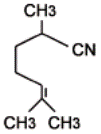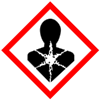|
Mubychem Group, is a mature manufacturing company since generations. Engaged in manufacture and supply of Pharmaceutical Intermediates and Excipients, Fragrances, Oil field & fracturing chemicals, Specialty tailor made grades of chemicals in India. With several manufacturing facilities in India and world wide contacts and toll manufacturers we are exporting to all the countries in the world.. |
The company and associated units have certificates & accreditations like FDA - GMP approval; ISO-9001 Certified; "REACH" Registered; ISO-22000; Kosher Certified; Halal Certified; HACCP. We offer Commercial Pure & Pharmacopoeia IP BP USP FCC Food Grade ACS AR Analytical Reagent Grades of Chemicals |
|
Citronellyl Nitrile Manufacturers, SDS MSDS Sheet
Citronellyl Nitrile
Chemical Name: 3,7-Dimethyl-6-octenenitrile
Chemical Formula: C10H17N
Synonym: Citronellic acid nitrile
CAS No.: 51566-62-2
Molecular Weight: 151.26
Odor
Description: Fruity, Floral –balsamic intense lemon
like, Agrumen like under tone, good tenacity
Application Information: Widely used in perfumery compositions due to its good chemical stability and
tenacity
Stability: Stable, does not cause discoloration
Uses: As a more stable substitute for citral, enhances citrus notes. Useful in herbal fragrances. It shows a very intensive odor reminiscent of citrus when diluted. It is an excellent substitute for Citronellal as an citric fragrance component for alkaline product bases.
CITRONELLYL NITRILE SDS MSDS SHEET, MATERIAL SAFETY DATA SHEET
1. PRODUCT AND COMPANY IDENTIFICATION
Commercial Name: CITRONELLYL NITRILE
CAS Number: 51566-62-2
EINECS EC Number: 257-288-8
Molecular Weight: 151.26
Molecular Formula: C10H17N
2. HAZARDS IDENTIFICATION
GHS, Globally Harmonized System Classification in accordance with 29 CFR 1910
Classification according to Regulation (EC) No 1272/2008
Skin corrosion/irritation Category 3
Sensitization, Skin Category 1
Serious eye damage/eye irritation Category 2A
Sensitization, respiratory Category 1
Hazardous to the aquatic environment, long-term hazard Category 2
Labeling according GHS & Regulation (EC) No 1272/2008
GHS Label Elements  Aquatic Toxicity |
|
Signal Words: Danger
Hazard Statements:
H315: Causes skin irritation.
H317 May cause allergic skin react.
H319: Causes serious eye irritation.
H334 May cause allergic or asthmatic symptoms or breathing difficulties if inhaled.
H411: Toxic to aquatic life with long lasting effects.
Precautionary Statements:
P261: Avoid breathing dust/fume/gas/mist/vapors/spray.
P264: Wash … thoroughly after handling.
P272: Contaminated work clothing should not be allowed out of the workplace.
P273: Avoid release to the environment.
P280: Wear protective gloves/protective clothing/eye protection/face protection.
P285: In case of inadequate ventilation wear respiratory protection.
P302+352: IF ON SKIN: Wash with soap and water.
P332+313: If skin irritation occurs: Get medical advice/attention.
P333+313: If skin irritation or a rash occurs: Get medical advice/attention.
P304+341: IF INHALED: If breathing is difficult, remove victim to fresh air and keep at rest in a position comfortable for breathing.
P342+311: If experiencing respiratory symptoms: Call a POISON CENTER or doctor/physician.
P305+351+338: IF IN EYES: Rinse cautiously with water for several minutes. Remove contact lenses if present and easy to do – continue rinsing.
P337+313: If eye irritation persists get medical advice/attention.
P362: Take off contaminated clothing and wash before reuse.
P391: Collect spillage.
P501: Dispose of contents/container in accordance with local/national regulation.
3. COMPOSITION / INFORMATION ON INGREDIENTS
Chemical Identification: 3,7-DIMETHYL-6-OCTENENNITRILE
CAS Number: 51566-62-2
EINECS EC Number: 257-288-8
4. FIRST-AID MEASURES
Always seek medical attention after first aid measures are provided.
Eye Contact: Rinse immediately with plenty of water for 10 minutes at least. Contact a physician if symptoms persist.
Skin Contact: Wash thoroughly with soap and water; flush with plenty of water. Take off spoilt clothes. Contact physician if symptoms persist.
Ingestion: Wash the mouth with water; seek medical advice immediately.
Inhalation: Remove from exposure site to fresh air and keep at rest. Obtain medical advice.
5. FIRE-FIGHTING MEASURES
Extinguishing Media Recommended: CO2, foam, dry chemicals.
Non Recommended: Do not use direct water jet on burning material.
Extinguishing Procedures: Closed containers may build up pressure at elevated temperatures. If possible, containers should be cooled with a water spray.
6. ACCIDENTAL RELEASE MEASURES
Personal Precautions: Use an individual protective equipment (waterproof boots, suitable protective clothing, safety glasses). Prevent any contact with hot surfaces. Do not approach facing the wind.
Environment Precautions: Keep away from drains, surface and groundwater and soil.
Method of Clean-up: Contain spilled material. Cover with an inert, non-combustible, inorganic absorbent material, or sweep up, and remove to an approved disposal container. Avoid open flames or other sources of ignition.
7. HANDLING AND STORAGE
Precautions in handling: Apply according to good manufacturing and industrial hygiene practices with proper ventilation. Do not drink, eat or smoke while handling. Respect good personal hygiene.
Storage Conditions: Store Citronellyl Nitrile in cool, dry and ventilated area away from heat sources and protected from light in tightly closed original container. Keep air contact to a minimum.
Fire Protection: Keep away from ignition sources and naked flame.
8. EXPOSURE CONTROL
Respiratory Protection: Avoid to breath directly on the product. Apply local ventilations when appropriate.
Ventilation: Ensure good ventilation of the work station.
Hand Protection: Avoid skin contact. Use chemical resistant gloves as needed.
Eye Protection: Use safety glasses.
Work Hygienic Practices: Wash hands with soap and water after handling.
9. PHYSICAL AND CHEMICAL PROPERTIES
Odor: Fresh, Citric, Floral
Color: Colorless to Pale Yellow
Appearance: Clear Mobile Liquid
Flash Point (C): 22
Boiling Point (C): 233
Melting Point (C): -20
10. STABILITY AND REACTIVITY
Reactivity: ------ Citronellyl Nitrile presents no significant reactivity hazards, by itself or in contact with water. Avoid contact with strong acids, alkali or oxidizing agents.
Decomposition: Carbon monoxide and unidentified organic compounds may be formed during combustion.
11. TOXICOLOGICAL INFORMATION
LD 50 ORAL/RAT (mg/Kg): 5300
LD 50 DERMAL/RABBIT (mg/Kg): > 5000
Carcinogenicity: No component of this product present at levels greater than or equal to 0.1% is identified as probable, possible or confirmed human carcinogen by IARC, ACGIH, OSHA and NTP.
12. ECOLOGICAL INFORMATION
Biodegradability: Not determined.
Precautions: Prevent contamination of soil, ground and surface water.
Carcinogenicity: No component of this product present at levels greater than or equal to 0.1% is identified as probable, possible or confirmed human carcinogen by IARC, ACGIH, OSHA and NTP.
Toxic to aquatic life with long lasting effects.
13. DISPOSAL CONSIDERATIONS
In accordance with local environmental laws. Avoid disposing into drainage systems and into the environment.
14. TRANSPORT REGULATIONS
DOT
Not regulated as dangerous goods.
IATA
Not regulated as dangerous goods.
IMDG
Not regulated as dangerous goods.
15. REGULATORY INFORMATION
USA:
OSHA: This product is a "Hazardous Chemical" as defined by the OSHA Hazard Communication Standard, 29 CFR 1910.1200.
CERCLA Hazardous Substance List (40 CFR 302.4): Not listed.
US. OSHA Specifically Regulated Substances (29 CFR 1910.1001-1050): Not listed.
SARA 304 Emergency release notification: Not regulated.
TSCA Section 12(b) Export Notification (40 CFR 707, Subpt. D): Not regulated.
Superfund Amendments and Reauthorization Act of 1986 (SARA)
Hazard categories Immediate Hazard - Yes
Delayed Hazard - No
Fire Hazard - No
Pressure Hazard - No
Reactivity Hazard - No
SARA 302 Extremely hazardous substance: Not listed.
SARA 311/312 Hazardous chemical: No
SARA 313 (TRI reporting): Not regulated.
Clean Air Act (CAA) Section 112 Hazardous Air Pollutants (HAPs) List: Not regulated.
Clean Air Act (CAA) Section 112(r) Accidental Release Prevention (40 CFR 68.130): Not regulated.
Safe Drinking Water Act (SDWA): Not regulated.
US. Massachusetts RTK - Substance List: Not regulated.
US. New Jersey Worker and Community Right-to-Know Act: Not listed.
US. Pennsylvania Worker and Community Right-to-Know Law: Not listed.
US. Rhode Island RTK: Not regulated.
US - California Proposition 65 - Carcinogens & Reproductive Toxicity (CRT), Listed substance: Not listed.
HMIS (Perceived): Health: 1, Flammability: 1, Reactivity: 1
NFPA Hazard (Perceived): Health = 1 Flammability = 2 Reactivity = 0
16. OTHER INFORMATION
EINECS: 257-288-8
Xi - Irritant
R 36/38 - Irritating to skin and eyes.
S 02 - Keep out of the reach of children.
S 24/25 - Avoid contact with skin and eyes.
S 36 - Wear suitable protective clothing.
H315: Causes skin irritation.
H317 May cause allergic skin react.
H319: Causes serious eye irritation.
H334 May cause allergic or asthmatic symptoms or breathing difficulties if inhaled.
H411: Toxic to aquatic life with long lasting effects.
Disclaimer:
***************************
Our company provides this
Citronellyl Nitrile SDS information contained
herein in good faith but makes no representation as to its comprehensiveness
or accuracy. This Citronellyl Nitrile MSDS sheet is intended only as a
guide to the appropriate precautionary handling of the material by a
properly trained person using this product. Individuals receiving the
information must exercise their independent judgment in determining its
appropriateness for a particular purpose.
***************************
Citronellyl Nitrile manufacturers at:
MUBY CHEMICALS
DONGRI-CHINCHBUNDER, MUMBAI 400009, INDIA
TEL: (OFFICE)
91-22-23770100, 23726950, 23774610, 23723564, 91-22-23728264
e-mail: info@mubychem.com












